Review and Practice for May 14th test:
- “Impulse: Designing a step-by-step diagram (This should take the place of written questions as you will be spending lots of time organizing information regarding voltage, ions, channels, etc.)
- 22 Provincial Multiple Choice questions – Practice these! Answers listed on bottom. (Remember: there are only so many MC questions per unit! The more you see, the better your odds of getting similar/identical questions on your unit test and final!)
- Additional Questions broken down by section:
Part 1: The CNS
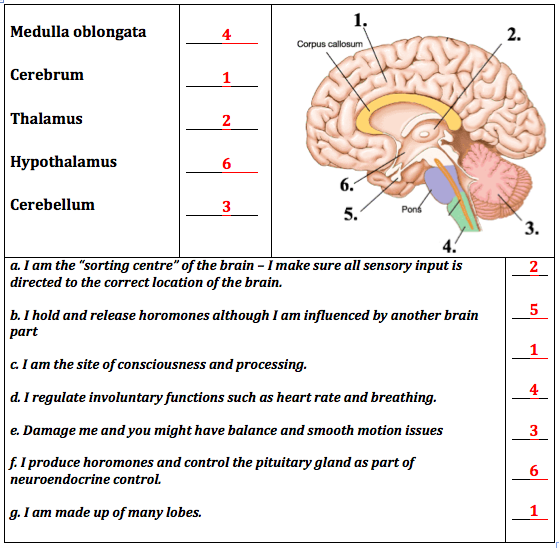
Part 2: Neurons
-
What is a myelin sheath? What are the benefits of myelination?
A protective fatty tissue called a myelin sheath wraps around nerves and many neural axons. The fatty sheath is made of Schwann Cells (a type of glial cell). The myeline sheath allows for: Insulation – prevent cross communication, Faster impulses, and protection. There is no ion movement under the Schwann cells, thus impulses are very rapid due to “hopping” between the gaps (Nodes of Ranvier).
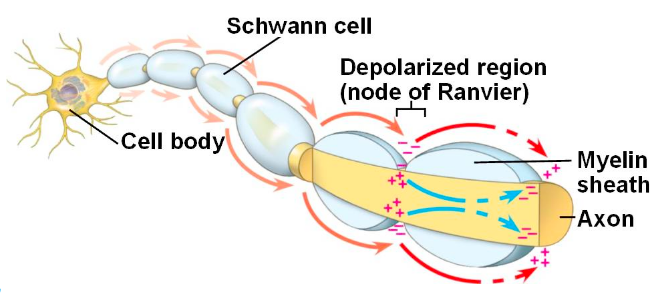
-
What is the difference between dendrites and axons? How are motor neurons and sensory neurons different in terms of structure and function?
Dendrite – Receives signal and conducts impulses toward cell body.
Axon – Conducts impulses away from cell body towards effector another neuron.
Sensory Neurons: Convert external stimuli from the environment into internal electrical impulses. (Touch, smell, pain, etc.). Very long dendrites.
Motor Neurons: Conduct impulses from CNS to an effector (i.e. muscle). Short dendrites that branch from cell body. Long axon.
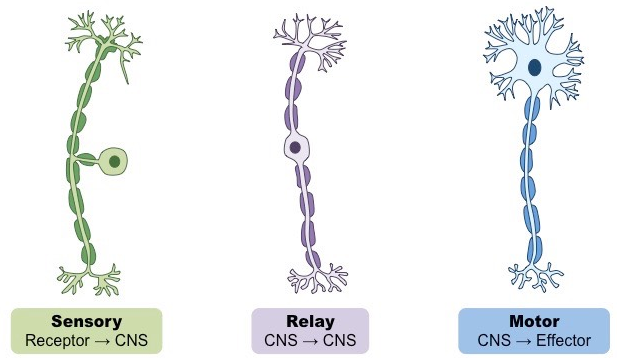
Part 3: Transmission
Complete your “Impulse: Designing a step-by-step diagram.” This should take the place of written questions as you will be spending lots of time organizing information regarding voltage, ions, channels, etc. I have included questions below if you want additional review practice.
-
Look at the graph of an action potential. Please label and describe what is happening at each stage.
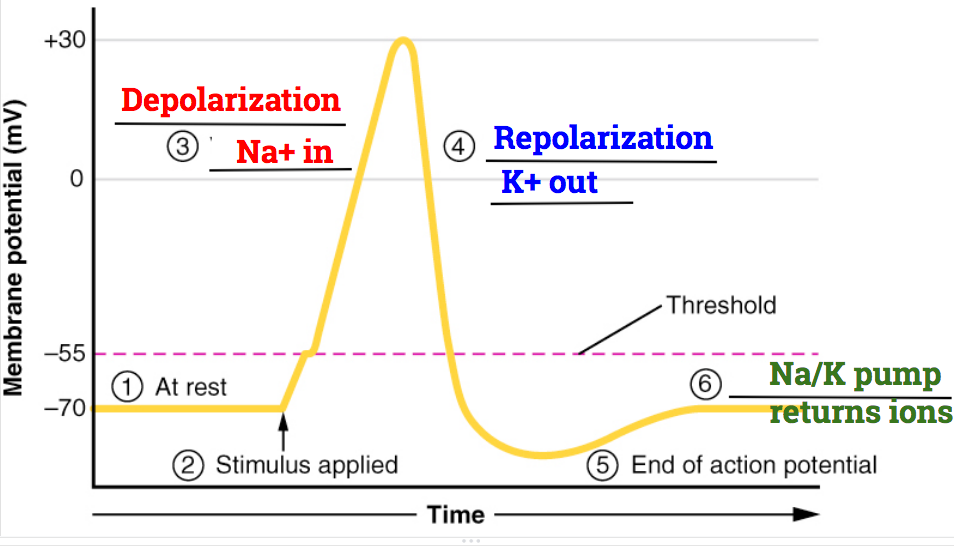
-
Which parts of an axomembrane maintain their levels of Na+ and K+ even during an action potential? Which areas change their levels of Na+ and K+ during an action potential?
Any part of the axomembrane wrapped in the mylien sheath. The Schwann cells prevent ion movement across the axomembrane. Thus, only at the Nodes of Ranvier do the levels of Na+ and K+ change during an action potential. This is saltatory transmission because the wave of depolarization “hops” between nodes.
-
While at a party, an unnamed person tried cocaine. The person liked the feeling of euphoria due to the release of dopamine and the inhibition of its reuptake. This person continued to use cocaine regularly for the next month, however the person is noticing they need more and more to get a similar effect. Describe what is happening in the synaptic gap that can explain this tolerance.
Cocaine attaches to the dopamine transporter, the conduit that draws dopamine out of the synapse and back into the pre-synaptic neuron. As long as cocaine occupies the transporter, dopamine cannot re-enter the neuron. It builds up in the synapse, stimulating the post-synaptic neuron receptors more consistently and producing much greater dopamine impact.
The brain responds to repeated drug-induced massive dopamine surges in part by reducing its complement of dopamine receptors (downregulation of the receptors). This alleviates the drugs’ overstimulation of the dopamine system, but also contributes to features of drug dependence (e.g., susceptibility to drug withdrawal) and of addiction (e.g., compromised ability to respond to normal dopamine fluctuations produced by natural rewards). So basically, due to the lowered amount of receptors and desensitization of the pathway more cocaine is needed to release even more dopamine and block reuptake even longer to consistently trigger stimulation as before.
-
Define upregulation. Give an example of when we could see this in an individual.
Upregulation: Cellular increase in the number of receptors to a molecule, such as a hormone or neurotransmitter, which increases the cell’s sensitivity to the molecule.
Ex. Dependence and overuse of opioids. Opioids (i.e. heroin/morphine) bind the pre-synaptic neuron and prevent substance P neurotransmitter release into the synaptic gap. Therefore, the signal cannot be passed (or is more difficult to pass) on to the post-synaptic neuron. A lack of signalling of pain is outside expected limits, so the body will upregulate nociceptors on the post-synpatic neuron and thus increasing its sensitivity to substance P.
-
Define downregulation. Give an example of when we could see this in an individual.
Downregulation: Cellular decrease in the number of receptors to a molecule, such as a hormone or neurotransmitter, which reduces the cell’s sensitivity to the molecule.
Ex. See cocaine example in question 3. Also, nicotine which binds to the same receptors of acetylcholine. Consistent stimulation causes the body to downregulate the receptors to decrease sensitivity.
5. Explain how we can perceive different intensities of sensation, even though neurons have an “all or nothing” approach to sending a signal.
- There is either a significant stimulus to begin an action potential or there is not and nothing happens.
- The action potential does not change – it is always the same regardless of how “intense” a stimuli is.
- The intensity of an impulse is based on how many neurons get activated and how frequently!
Part 4: PNS/Endocrine Control
-
Define: autonomic nerves and somatic nerves.
Autonomic nerves are nerves (multiple neural axons/dendrites surrounded with fatty myelination) that work to control the autonomic nervous system – involuntary actions. Any effectors/sensory structures involved in these are autonomic neurons/nerves (ex. baroreceptors sensing blood pressure and signalling the medulla oblongata)
Somatic nerves are nerves that work on voluntary movement. Think about the processes involved with the reflex arc and moving our hands away from a painful stimuli.
-
Describe what is meant when we say the two branches of the autonomic nervous system being “antagonistic.” Support this with an example.
They work on the same areas with opposite effects.
Ex. they can regulate heart rate through either excitatory or inhibitory neurotransmitters, depending on the body’s response.
Sympathetic releases norepinephrine = increased heart rate, decreased digestive activity, etc.
Parasympathetic releases acetylcholine = decreases heart rate increases digestive activity, etc.
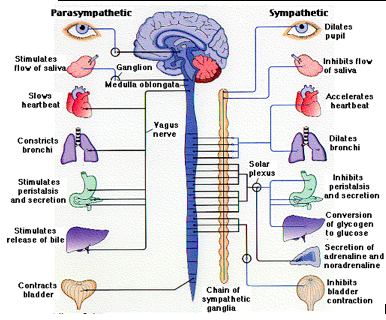
-
What two substances are released during a “fight or flight” response. What releases these substances? What are some changes these cause in our body?
In neurons – norepinepherine (adrenaline), from adrenal glands – epinephrine (adrenaline)
- Increased heart rate – more blood to body quickly.
- Blood flow altered – contraction of surface tissue arterioles (going pale) and digestive system. More to skeletal muscles.
- Widening of airways – More gas exchange with each breath
- Contraction of skeletal muscles – tensing up, ready for action (includes diaphragm (“gasping” when scared)
- Contraction of iris – wide pupil, more visual alertness
- Glycogen -> glucose for ATP production promoted
Comments by shaun pletsch